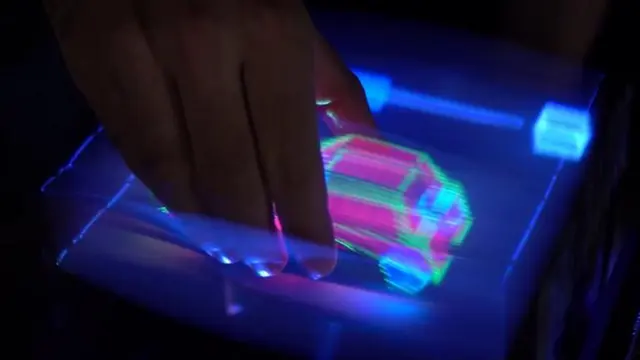It sounds like something pulled straight from a Star Wars holodeck or Iron Man’s lab, but it’s 100% real. A team of Spanish scientists has just made the first-ever touchable 3D holograms that float in mid-air—no headsets, no gloves, just pure science-fiction-level coolness come to life.
This breakthrough, led by Dr. Elodie Bouzbib at the Public University of Navarra (UPNA), pushes holographic tech lightyears beyond what current commercial displays can do. Instead of merely watching floating images, users can now interact with them directly—grabbing, dragging, and manipulating visuals with their bare hands.
“We’re enabling natural interaction with 3D graphics,” said Asier Marzo, one of the lead researchers. “It’s as intuitive as tapping a phone screen—but in mid-air.”
The Science Behind the Magic
Typical volumetric displays work by projecting rapid-fire images (up to 2,880 per second!) onto a diffuser surface. Thanks to persistence of vision, your brain stitches these frames into a complete 3D object, like a cube floating before your eyes.
The problem? These diffusers are usually rigid and fast-moving, which means sticking your hand into them could be… let’s say unwise. To solve this, the team swapped out the rigid materials for elastic ones that are safe to touch.
Of course, elastic surfaces distort when touched—so the scientists had to develop real-time image correction to maintain visual clarity. The result? A fully functional, safe-to-touch volumetric display that responds to your hands like a holographic touchscreen.
Walk With Your Fingers, Pinch to Move
The prototypes already offer surprisingly fun and intuitive interactions. Want to rotate a cube? Just pinch it between your fingers and twist. Want to simulate walking? Make a little finger-leg strut across the display. Yes, really.
Real-World Potential: From Classrooms to Museums
This isn’t just a lab toy—it has serious real-world potential. Imagine students assembling a 3D engine model in physics class or museum visitors interacting with floating artifacts—no glasses or gear- just walk up and engage.
Even better? These displays are multi-user friendly. Everyone can see and touch the same floating objects from different angles, making them perfect for collaborative work, teaching, and immersive storytelling.
Next Stop: Japan
The team is sharing their results at the prestigious CHI 2025 conference in Yokohama, Japan, from April 26 to May 1. If you want to geek out early, their demo video is already up on YouTube, and their paper is available on the HAL open-access research archive.



A “Star Wars holodeck”? Please correct this 🙂